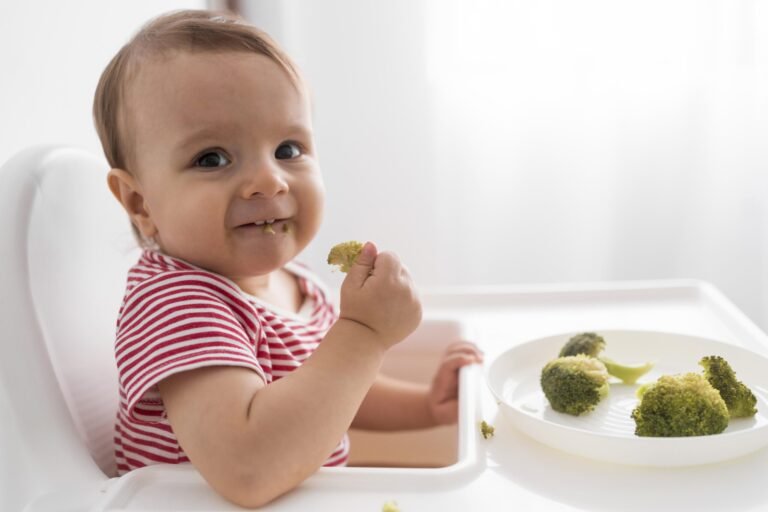
What Are the Benefits of Baby-Led Weaning? A Parent's Guide to Healthier, Happier Mealtimes!
The initiation of baby food presents itself as a primary decision for all new parents along the food introduction process. Traditional spoon-feeding has been maintained for many decades but parents currently select the hands-on approach of baby-led weaning (BLW) as their preference when introducing solids. But is it really better? This blog evaluates why parents select baby-led weaning instead of other methods because of its advantages.
What Is Baby-Led Weaning?
Infants start solid food consumption by themselves when parents opt for a baby-led weaning approach which enables children to touch their own food. Babies at six months old can properly eat small pieces of bread together with soft fruits and vegetables. Through this approach babies master self-regulation together with eating independence because they control their own eating action.
Benefits of Baby-Led Weaning
Baby-led weaning isn’t just about letting babies feed themselves—it’s packed with a variety of benefits that can have long-term positive effects on their development and eating habits.
Transitions to Self-Control Abilities and Encourages Proper Nutrition Practices
Self-regulation functions as a primary benefit of implementing baby-led weaning methods. Self-feeding enables infants to interpret their body signals thus they learn to recognize feelings of being full. Infants can build healthy eating habits through self-fed approaches because this method lets them recognize their hunger signals and recognize signs of being full. Self-regulation practices in babies develop healthy eating patterns that prevent future overeating problems during their growth.
Supports Developmental Milestones
Syntactically different foods and textures appear in babies’ diets during initial baby-led weaning stages. Child-led self-feeding under BLW enables proper development of coordination abilities and motor skill functions. Self-feeding promotes children’s hand-eye coordination through hand control which results in better manual dexterity abilities. Different textured foods that babies chew on during baby-led weaning help to develop their oral motor skills before they advance to more sophisticated foods in their growth.
Reduces Picky Eating
The preventive approach of baby-led weaning helps avoid the widespread occurrence of picky eating behavior, which is a common concern for many parents. Exposure to various taste combinations, along with different food textures during infancy, directly contributes to better food diversity tolerance in later stages of eating. Allowing infants to touch and feel food during exploration helps them develop into more adventurous eaters, as they learn to accept a variety of food types as they grow older.
Encourages Family Meals
With the baby-led weaning practice, infants can participate in family meals from their very first day. Watching eating and social interactions at the table provides infants with opportunities to develop their social and emotional skills. Family dining moments become more enjoyable as infants join in the communal activities and begin to understand their active role in shared conversations. This bonding experience fosters positive associations with food and mealtime.
Through BLW, Children Create Favorable Relationships with Food
The fundamental aspect of BLW teaches children to freely explore foods so they develop positive nutritional relationships. Children under the BLW method always receive total freedom from eating restrictions throughout their process of food exploration. This learning experience promotes a reduction in future food-related stress which builds a positive dining atmosphere for children and their parents.
Is Baby-Led Weaning Safe?
Baby-led weaning depends on safety considerations because of its multiple benefits. The risk of choking during weaning often triggers parental concerns but parents can minimize these risks through proper prevention strategies together with continuous observation. Your baby requires safe portions of foods, and you should always monitor their eating time. You should initiate baby-led weaning through food intake starting with smooth items suitable for holding and consuming into the mouth such as cooked sweet potato and mashed avocado and banana. Small spherical food items such as grapes and popcorn must remain out of reach due to their potential hazards to babies’ swallowing systems.
Before beginning baby-led weaning you must obtain professional pediatric evaluation to verify proper readiness and dietary needs for your baby.
How to Get Started with Baby-Led Weaning
The following guidelines will help you initiate baby-led weaning when you are ready to begin:
- Start at the Right Time: Initiating solid foods becomes appropriate when your baby turns six months old but must show readiness signs such as good sitting position and interest in food.
- Choose the Right Foods: Food selection during baby-led weaning must include easy-to-grasp items since infants need to hold their food without difficulty. Soft fruits together with cooked vegetables along with scrambled eggs work well as first foods for babies.
- Be Patient: Patient behavior is essential for developing self-feeding competence through BLW methods. Allow your baby to experience food-related challenges while giving them the freedom to learn to eat independently. Your little one needs many opportunities to practice mouth movements and swallowing until they develop sufficient chewing and swallowing skills. Your babies need enough time to finish their meals so provide them with abundant eating periods.
- Supervise Closely: Feeding should always take place under your direct supervision, and your baby should be seated upright to ensure safety from choking hazards.
A new beneficial procedure provides guidance for solid food introduction to infants. Babies who explore food independently create positive eating behaviors with improved movement abilities while escaping meal difficulties.
The process of solid food introduction to babies has an exciting and useful approach that allows parents to create positive weaning experiences by applying essential safety measures.
Have you tried baby-led weaning? Leave your response regarding BLW in the comment section and I will provide answers to initial questions about starting this process.
